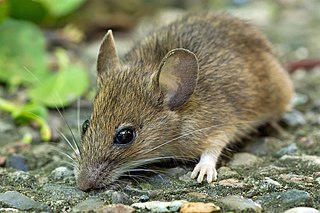Related Research Articles

The yellow-necked mouse, also called yellow-necked field mouse, yellow-necked wood mouse, and South China field mouse, is closely related to the wood mouse, with which it was long confused. It was only recognised as a separate species in 1894. It differs in its band of yellow fur around the neck and in having slightly larger ears and usually being slightly larger overall. Around 100 mm in length, it can climb trees and sometimes overwinters in houses. It is found mostly in mountainous areas of southern Europe, but extends north into parts of Scandinavia and Britain. It facilitates the spread of tick-borne encephalitis to humans and is a reservoir species for the Dobrava virus, a hantavirus that is responsible for causing haemorrhagic fever with renal syndrome.

The wood mouse is a murid rodent native to Europe and northwestern Africa. It is closely related to the yellow-necked mouse but differs in that it has no band of yellow fur around the neck, has slightly smaller ears, and is usually slightly smaller overall: around 90 mm (3.54 in) in length and 23 g in weight. It is found across most of Europe and is a very common and widespread species, is commensal with people and is sometimes considered a pest. Other common names are long-tailed field mouse, field mouse, common field mouse, and European wood mouse.

The striped field mouse is a rodent in the family Muridae. The range of this species stretches from Eastern Europe to Eastern Asia.
The Sichuan field mouse is a species of rodent in the family Muridae. It is found in Qinghai and Sichuan provinces of China, and in India and Burma.

The Taiwan field mouse, also called Formosan wood mouse, is a species of rodent in the family Muridae. It is found only in Taiwan.

The Ural field mouse is a species of rodent in the family Muridae. It is also known as the pygmy field mouse. It is found in Armenia, Austria, Azerbaijan, Belarus, Bulgaria, China, Croatia, Czech Republic, Estonia, Georgia, Hungary, Kazakhstan, Latvia, Liechtenstein, Lithuania, Mongolia, Montenegro, Poland, Romania, Russian Federation, Serbia, Slovakia, Turkey and Ukraine.

Histiostomatidae is a family of astigmatid mites and branches basically in a phylogenetic tree of the Astigmata.
The Macronyssidae are a family of parasitic mites in the order Mesostigmata.
Prolistrophorus bakeri is a parasitic mite in the genus Prolistrophorus. Together with the Argentine P. hirstianus, it forms the subgenus Beprolistrophorus. P. bakeri has been found on the hispid cotton rat, marsh rice rat, and cotton mouse in Georgia, South Carolina, Texas, and Florida and on Oryzomys couesi in Colima. It was formerly placed in the genus Listrophorus.
Horstia is a genus of mites in the family Acaridae.
Rhinoseius is a genus of mites in the family Ascidae.
Otopheidomenidae is a family of mites in the order Mesostigmata.
Halarachnidae is a small family of mites in the order Mesostigmata.
Amur virus (AMRV) is a zoonotic negative-sense single-stranded RNA virus. It may be a member of the genus Orthohantavirus, but it has not be definitively classified as a species and may only be a strain. It has been identified as a causative agent of hemorrhagic fever with renal syndrome.
Apodemus avicennicus is a species of rodent found in Iran.
Myobiidae is a family of mites, containing the following genera:
Demodex huttereri is a hair follicle mite found in the Meibomian glands of the striped field mouse, Apodemus agrarius.

Glycyphagidae is a family of mites in the order Astigmata. There are more than 25 genera and 100 described species in Glycyphagidae.

Sennertia is a genus of mites in the Chaetodactylidae family. There are more than 70 species. Some of these mites are parasites or commensals of bees, but the presence in some bees of specialized structures for carrying mites (acarinarium) indicates the mutualistic nature of the relationship of some species. Most species of the genus Sennertia settle on adult bees as heteromorphic deutonymphs, but the species Sennertia vaga has no deutonymph and settle on adult bees in the eating adult stages. Reproduction and feeding occurs during resettlement. Most species occur on small carpenter bees (Ceratina) and large carpenter bees (Xylocopa) of the family Apidae. A few species are associated with Centris (Paracentris) in the Neotropics.
Fritz S. Lukoschus (1919–1987) was a German zoologist studying the systematics and biology of the Acari. Over the course of his career he published over 200 scientific articles, describing more than 90 species new for science. Lukoschus was born in April 1919 in Grabsten in April 1919. He obtained his PhD in 1946 from the University of Göttingen on a thesis on the development of castes in the European honey bee. After working at the University of Göttingen until 1953, he worked at several institutions before being recruited by the Catholic University of Nijmegen in 1962 where he stayed until his retirement in 1984. Lukoschus died suddenly in August 1987. The genera Lukoschus and Lukoschuscoptes were named after him.
References
- ↑ "Myobiidae". Joel Hallan's Biology Catalog. Texas A&M University. Archived from the original on March 5, 2005. Retrieved October 9, 2013.